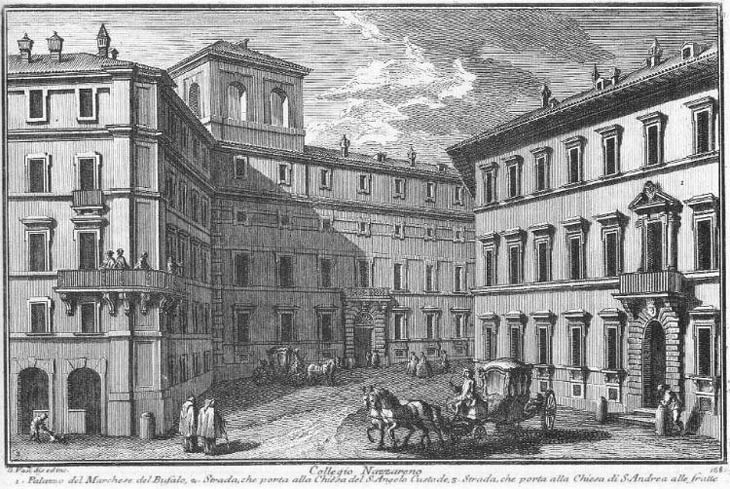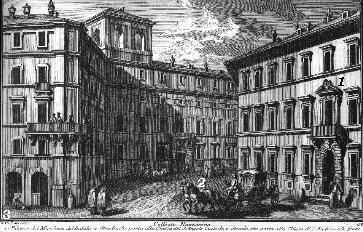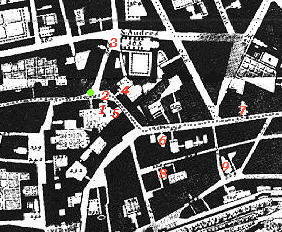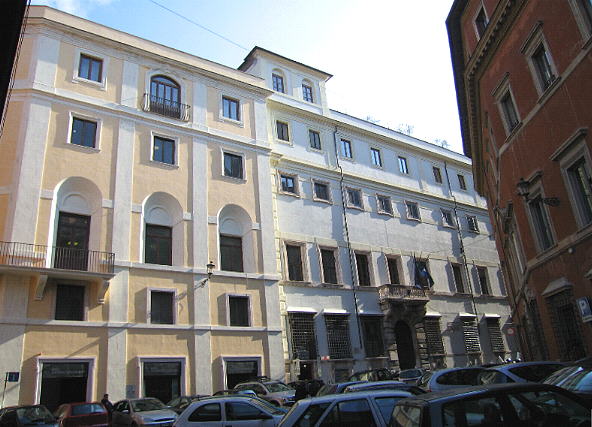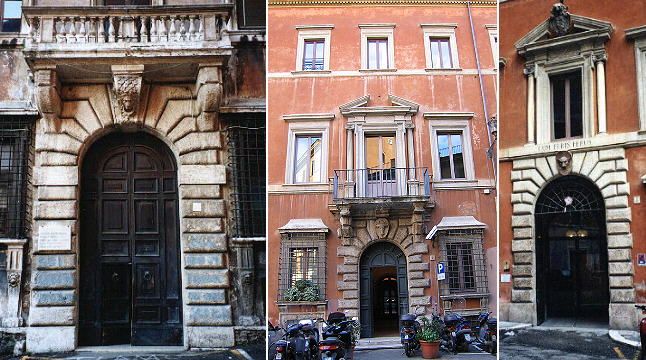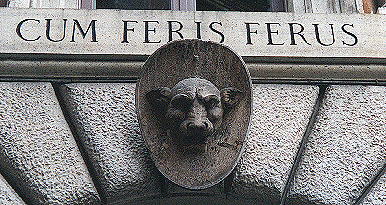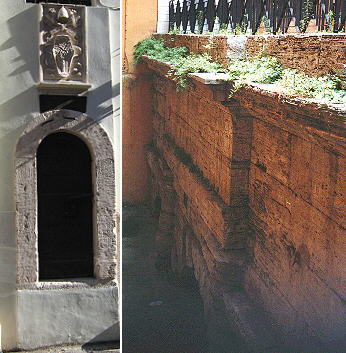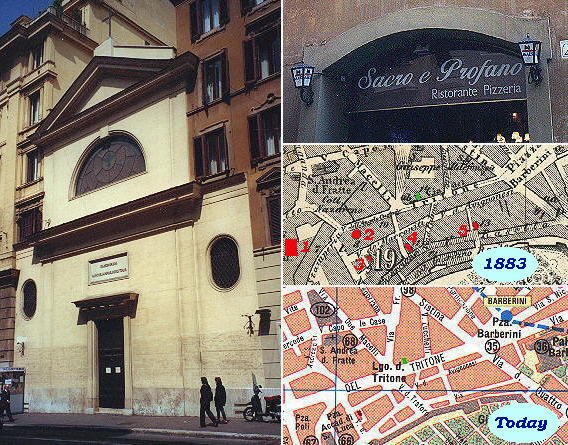

Collegio Nazzareno (Book
9) (Map
B2) (Day 3) (View C6)
(Rione Colonna) and (Rione Trevi)
In this page:
The plate by Giuseppe Vasi
Today's view
Details of Collegio Nazzareno and Palazzo
del Bufalo
Motto of the Del Bufalo
Acqua Vergine
S. Maria in Costantinopoli and some lost churches
The Plate (No. 168)
It is unlikely to find in today's guides a reference to this building near S.
Andrea delle Fratte, yet old guides, influenced by this plate, often
quoted this College founded in 1622 for the education of poor boys. The view is taken from the green dot in the 1748 map below.
In the description below the plate Vasi made reference to: 1) Palazzo Del Bufalo; 2) Street leading to Chiesa dell'Angelo Custode; 3) Street leading to S. Andrea delle Fratte.
The map shows also 4) Collegio Nazzareno; 5) Ruins of Acquedotto dell'Acqua Vergine; 6) Chiesa dell'Angelo Custode; 7) S. Maria di Costantinopoli; 8) S. Giovanni dei Maroniti; 9) S. Nicola in Arcione.
The dotted line in the small map delineates
the borders between Rione Colonna (upper half) and Rione Trevi (lower half).
Today
The main body of the college is the same, but the left wing looks
quite different. The palace is still a (private) school and has retained
the old name.
Details
The portal of Collegio Nazzareno (left) was most likely taken as a model for those of Palazzo Del Bufalo.
Sometimes
it is
Necessary...
..to adopt the motto of Palazzo Del Bufalo (with the wild ones be
wild).
Acqua
Vergine
In the street leading to Via del Tritone there is a coat of arms of Sixtus IV (it's the background
of this page) which celebrates the restoration of the Acqua Vergine aqueduct (the roman arches are visible between two modern buildings). Acqua Vergine
is the aqueduct bringing water to Fontana di Trevi.
Old
Churches
Via del Tritone which now links Piazza Colonna
with Piazza
Barberini was in the XVIIIth century just a small street. Its enlargement at the end of the XIXth century
together with the opening of a tunnel under the Quirinal led to many changes
in the area near Collegio Nazzareno. Part of Palazzo Poli (or Conti) (1) and the churches of S.
Nicola in Arcione (4) and Chiesa dell'Angelo Custode (2) were pulled down. S. Giovanni dei Maroniti (3) is today a restaurant, which
is rightly named Sacro e Profano (Sacred and Profane). S. Maria della Neve o dei Foglianti (5) is another lost church.
Palazzo De Angelis a large XVIIIth century building
next to Collegio Nazzareno was thoroughly "modernized". The church of S. Maria di Costantinopoli
has lost its XVIIIth century appearance for another reason. In 1799 the troops of Francis IV, king of the two Sicilies (Sicily and Naples)
forced the French out of Rome and celebrated their victory in this church which belonged to the Sicilian Nation in Rome.
When the French returned to Rome they retaliated by demolishing the church. It was rebuilt in 1817.
Excerpts from Giuseppe Vasi 1761 Itinerary related to this page:
Collegio Nazzareno, e chiesa de' ss. Angioli Custodi
Dal Card. Michelangelo Tonti, che lo fondò prese un tal nome questo collegio, perchè era
Arcivescovo di Nazzaret; e altresì perchè alla ss. Vergine col titolo di Nazzaret è dedicata la cappella
di questo. Stava prima sulla salita di s. Onofrio, ma concorrendovi de' convittori nobili, ed in
gran numero, fu quivi trasportato, ed eretto nel medesimo palazzo del suo Fondatore, e si estende
fino alla strada de' ss. Angeli Custodi, in onor de' quali fu dedicata la chiesa
che ivi si vede eretta da una Confraternita di devoti fedeli; il quadro nell'altare maggiore è di
Giacinto Brandi, ed il s. Antonio di Padova di Luca Giordani. Quindi camminando più oltre verso
piazza Barberini, evvi a sinistra la
Chiesa di s. Maria di Costantinopoli
La nazione Siciliana con li soccorsi del Re Cattolico Filippo II., e del Card. Simone Tagliavia eresse circa l'anno 1515.
questa chiesa in onore della ss. Vergine sotto il titolo di Idria, come dicemmo altrove, titolo molto
celebre, ed antico nella Città di Costantinopoli; ma in oggi per l'ignoranza di ciò, dal volgo l'è stato
mutato in quello di Costantinopoli. Sonovi delle cappelle ornate di marmi, e di pitture. Il quadro di
s. Francesco Saverio nella prima cappella a destra è diGio: Qualiata; la s. Rosalia nell'altra è di
Gio: Valerio Bolognese; il s. Corrado in quella incontro, è di Alessandro Vitale; il s. Leone Papa
nell'ultima, .di Pietro del Po, e la s. Agata, e la s. Lucia nei laterali sono di Francesco Ragusa. Vi è
unito l'ospizio per
i pellegrini, e l'oratorio per li fratelli ascritti. Indi entrando nel vicolo incontro a questa, si trova a sinistra la
Chiesa di s. Nicola in Arcione
Dall'antico foro Archimonio si crede, che prendesse il nome questa chiesa, corrotto poi in Arcione.
E' antica parrocchiale, e ne hanno cura i Frati Serviti, i quali l'hanno rinnovata, ed adornata di varie pitture.
il s. Antonio di Padova nel primo altare a sinistra, ed il s. Francesco nel secondo sono di un allievo di
Andrea Sacchi; il s. Niccolò, ed il s: Filippo Benizi nell'altare maggiore sono di Pietro Sigismondo da
Lucca; il s. Lorenzo nella cappella, che siegue è di Luigi Gentile; quello nell'altra del Cav. d'Arpino,
l'ultimo viene dal Maratti, e le pitture nella volta erano di Giuseppe Passeri.
A sinistra di questa chiesa, e sulla strada Rosella evvi quella dedicata a s. Maria della Neve,
coll'ospizio de' monaci Fugliensi della congregazione di Francia; e ritornando a destra, si trova nel
secondo vicolo il collegio, e chiesa di s. Gio: de' Maroniti.
|
Next plate in Book 9: Collegio de' Neofiti
Next step in Day 3 itinerary: Fontana
di Trevi
Next step in your tour of Rione Colonna:
Chiesa dei Cappuccini
Next step in your tour of Rione Trevi: Palazzo Sciarra

Go
to  or to Book
9 or to my Home
Page on Baroque Rome or to my Home Page on Rome
in the footsteps of an XVIIIth century traveller.
or to Book
9 or to my Home
Page on Baroque Rome or to my Home Page on Rome
in the footsteps of an XVIIIth century traveller.
|


